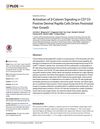TLDR The dermal papilla interacts with the epidermis to control hair growth and development.
The document discussed the role of dermal-epidermal interactions in hair follicle development and cycling, emphasizing the importance of the dermal papilla. The dermal papilla, a stable population of specialized fibroblasts, interacted with the epidermis to ensure follicle development and continued to influence the follicular epidermis throughout the hair cycle. The study suggested that the papilla provided factors that stimulated epidermal proliferation, initiating and sustaining anagen and follicle morphogenesis. Additionally, the dermal component of the follicle mediated the influence of systemic factors, such as androgens, on hair growth. The findings indicated that understanding these interactions could reveal intrinsic control mechanisms regulating hair development and growth in both normal and disease states.
106 citations
,
April 1986 in “British Journal of Dermatology” Dermal papilla cells from human hair follicles form unique structures and don't live as long as other skin cells in lab conditions.
30 citations
,
February 1977 in “Nature” The dermal papilla can still grow new hair even after heavy radiation.
55 citations
,
February 1975 in “Journal of Cutaneous Pathology” Dermal cell activity increases during hair growth in rats.
 9 citations
,
August 2018 in “Biomedical dermatology”
9 citations
,
August 2018 in “Biomedical dermatology” A peptide called DPS-1 helps human scalp cells grow and stimulates hair growth in mice.
 26 citations
,
July 2016 in “PLOS ONE”
26 citations
,
July 2016 in “PLOS ONE” Activating β-catenin in certain skin cells speeds up hair growth in mice.
 April 2016 in “Journal of Investigative Dermatology”
April 2016 in “Journal of Investigative Dermatology” Wnt ligands, produced by dermal papilla cells, are essential for adult hair growth and regeneration.
 184 citations
,
November 2014 in “Developmental Cell”
184 citations
,
November 2014 in “Developmental Cell” Hair follicle dermal stem cells are key for regenerating parts of the hair follicle and determining hair type.
86 citations
,
August 2000 in “Pigment cell research” Melanocyte activity in hair follicles is linked to the hair growth cycle, being active in growth phases and inactive in rest phases.
154 citations
,
October 1996 in “Proceedings of the National Academy of Sciences of the United States of America” Estrogen affects hair growth and skin cell multiplication.




